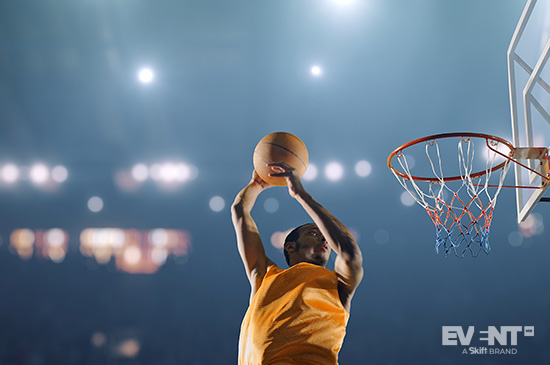Although the NBA suspended its season back in March due to the pandemic, it officially resumed games on July 30th — with some major changes. For starters, the games are all being held at venues within Disney World’s ESPN Wide World of Sports Complex in Orlando, Florida.
Players, coaches, trainers, and everyone else involved are required to remain inside what has been coined the Orlando Bubble, with strict quarantine and testing measures in place.
Perhaps the biggest change, however, is the lack of a live audience in the stands. Fans will not be allowed in-person for the remainder of the season, and potentially into next season. In order to fill this void, the NBA developed a unique virtual fan experience using Microsoft Teams that allows fans to remotely attend games on 17-foot-tall LED screens around the courts.
This experience has been an interesting case study and can provide some important tips as we continue to embrace virtual and hybrid events.
Ensuring On-Site Safety
The NBA has implemented extensive procedures to ensure the safety of all those within the Orlando Bubble to the best of their ability, including frequent testing of players. The NBA trialled saliva-based tests developed at Yale, which have now been approved by the FDA for public use. These tests have three important features: they require only spit, they remove the RNA extraction from the process, and they can be processed by any lab that goes through the required accreditation. This means that results can be provided in a matter of hours, depending on how far the nearest qualified lab is.
The NBA also enforces quarantines for anyone entering the Bubble, maintains a clinic within the campus, and offers players and staff wearable tech that includes an alarm that goes off if someone is within 6 feet of another alarm device for more than 5 seconds.
While not all of the NBA’s measures will be realistic for other events, specifically the lengthy quarantines, strict safety protocols will be crucial for all hybrid events moving forward in order to protect attendees, speakers, staff, and other stakeholders.
Promoting the “Virtual Fan Experience”
In marketing the virtual fan experience, NBA teams have focused on conveying value to fans and leveraging the exclusive nature of the opportunity. The “Virtual Fan Experience” is clearly very distinct from the experience of watching the game on TV, and there are only a limited number of virtual seats per game, which helps build excitement.
For example, the LA Clippers emphasize the fact that the virtual seats will be visible on the game’s broadcast, which is an appeal of attending a live game that is now possible virtually.
In addition, their messaging speaks to fans’ desire to cheer on their teams along with other supporters: “The experience gives you the exclusive opportunity to support the squad with your fellow Clipper Nation fans.”
While virtual and hybrid events generally allow for a wider reach, limiting the amount of spots available can help generate the type of FOMO that live events are known for and that has largely been missing from the virtual space.
This has also allowed sponsors such as Michelob ULTRA to promote the experience through giveaways, much like they would for in-person games:
The @NBA Season is here! Who’s going to the Finals? Possibly you. Reply with #ULTRACourtside and #Sweepstakes for a chance to win 2 virtual courtside seats to the NBA Finals. pic.twitter.com/VnxKoROaav
— Michelob ULTRA (@MichelobULTRA) July 30, 2020
Connecting Remote Audiences to the Live Venue
Participants of the NBA’s virtual experience can watch the game in real-time and are connected to the venue via a live video and audio feed, meaning that virtual attendees are not simply silent viewers — they can be seen and heard by the players, as well as by the other fans in their section, making it almost as if they were physically in the stands.
In addition, game hosts and announcers participate in the virtual experience to help keep the energy up by starting chants during key points of the game, for example. Since each remote attendee can be seen in the virtual stands, engagement is all but guaranteed — a seat that has been left empty for too long will be filled with another fan from a standby queue.
This element of two-way communication between the live venue and the remote audience will be an essential part of upcoming hybrid events in order to promote exchanges between all attendees and make sure that virtual participants feel included in the event.
IN CONCLUSION
Most industries have relied heavily on virtual technology over the past few months in order to weather the pandemic. So far, the NBA is the only major sports league to attempt this kind virtual experience, although the NFL will be doing something similar during its games.
The NBA’s execution of its virtual experience is a unique example of how an online audience can be immersed in a live experience. Combined with the league’s handling of on-site safety protocols, it provides a useful learning opportunity for planners organizing hybrid events in the near future.





